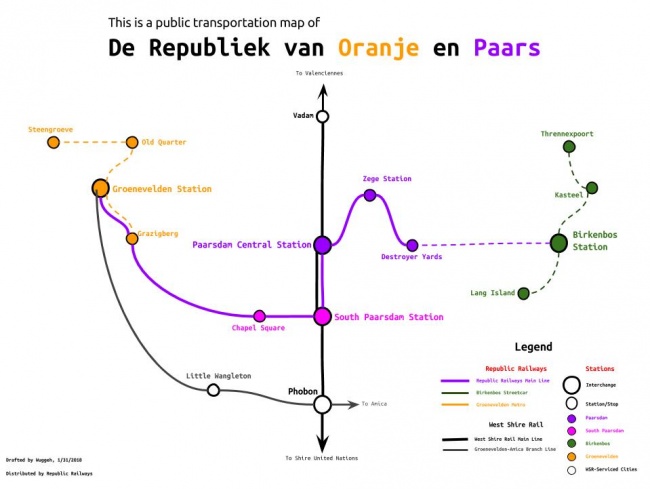Republic of Orange and Purple
The Republic of Orange and Purple (Dutch: De Republiek van Oranje en Paars or De Republiek van Oranje en Purpur) is a Constitutional Republic located in the Western Sea in the Thrennex region of The Shire. It's capital is Paarsdam, which was built upon massive stone foundations which rise hundreds of meters from the ocean floor. The Republic primarily speaks Dutch and English, with some Old Britannian still spoken in small communities.
Founded in 1681 CE from naval elements of the shattered Old Britannian tribes, after the Sammichian Razing of Britannia, the "floating city" of Paarsdam was the newly-established center of the sea-faring nation. Stone bricks, carved from beneath the snowy wastes of the frozen continent to the north, were used to expand the tiny island on which the Britannians first landed. From there, the city of Paarsdam expanded to become a thriving epicenter of commerce, industry, and culture in the Western Shire. Initially a Kingdom, the Republic itself was founded in 1698, and was joined by the surrounding provinces of Groenevelden, South Paarsdam (a separate province by governance and population), and Birkenbos, which operate as cooperative autonomous regions within the centralized government. The Republic also maintains seven forts and fortresses in and around the Western Sea, protecting its territories and people from invasion by land and sea.
The government of the Republic is a Parliamentary system, which elects an executive Prime Minister who holds the power to legislate, veto, and order, but is checked by the power of the parliament. The current elected leader is Wuggeh of Maine. While the Republic does not allow private land-owning, it does allow for land Stewardship and development, provided that the steward pays for the development and utilities provided, in exchange for personal property protections provided by the state. The Stewards are represented by the House of Stewards in Parliament, in collaboration with the House of Provinces, the second, higher house of Parliament representing the population of the provinces as a whole.
History
Old Britannia (250 PSY-1679 CE)
Full Article: Britannia
The Britannian War
Full Article: The Britannian War
The Rise of Paarsdam (1680-1750 CE)
The Crisis of 1680
Following the Britannian War, the federation composed of Nooters from Groenevelden and the Zeeders of South Paarsdam was left intact to dissuade the enemies of the Britannian people from attacking. In the years directly following the war, plague and famine overtook the surviving Britannians, as years of total war caught up on the population, and the influx of refugees from the destroyed civilizations pushed society to its limits.
In order to prevent a total collapse of Britannian society, delegates of all walks of life were called to a series of congresses. Solutions were presented by prominent members of Britannian society to the anxious gathering, which were then debated and voted upon, one by one. Solutions to the population crisis included:
- Sending masses of colonists north to the frozen continent of Thrennex. This was rejected for its clear injustice, as most of the colonists would be Suuth and Rivermensen refugees, who already faced the worst of the wartime and postwar famines.
- Searching the vast Western Ocean for the rumored city of “Westen Aarde”, subject of fables and myths, detailing untold riches. This was dismissed by all parties except for the clergy and certain forces in the military.
- Resettling the conquered lands. While this was an attractive option for some, most refugees did not want to return to their desolate fields and destroyed towns. The Treaty of Activia also banned official settlement of the razed territories without express permission of Fulfwotz (and vice versa).
With the Congress getting nowhere, a Rivermensen delegate, Kristiaan van Tyne, presented a bizarre solution. Using advanced construction techniques learned from books of the Solurian Empire, massive solid stone brick formations could be built in the shallow shoals of the Westenzee, upon which a great city could be built.
This final idea halted the entire conference and caused much intrigue amongst the leaders of The Federation. Some scoffed, but the majority found the technology fascinating, and praised the schematics and potential benefits of planning an entirely new city on oceanic resources. The Congress of Grinvalde (1684) ratified the agreement, and with funding from the Merchants guilds, Kristiaan van Tyne was given permission to erect the city of Paarsdam.
Formation of The Republic
With the Britannian peoples eager to begin “collective creation” (a national consciousness in peacetime among Britannians today), another conference was called by the Merchant Guilds of Nooter and Zeeder. This time discussion was made of a centralized government between the two nations, forming the long-lived Federation into a Republic.
Debates were had and feelings oftentimes ran hot, but after months of cooperation and compromise, the assorted representatives had a seemingly operational plan for a government. The plans included three houses (later reduced to two in 1830), a constitution detailing the duties and regulations of each house, and a
Trade and Influence
The Great Centralization (1750-1850 CE)
"Welfare of the Masses"
The Great Crises (1850-1950 CE)
The Great Wars of the Shire
Modern Era (1950-Present Day)
Government
Provincial Governments
Demographics
Culture
Economy
Political Relations
Build Information
Visiting The Republic
There are several ways to get to the Republic of Orange and Purple. The easiest way is to /warp to either of the following warp locations:
/warp paarsdam or /warp Groenevelden
However, should you desire to visit the other locations within the Republic, use this map of the local transportation:
